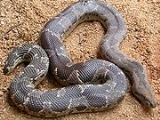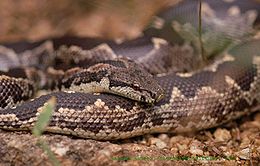
Gongylophis conicus
Encyclopedia
- Common names: rough-scaled sand boa, rough-tailed sand boa.
Gongylophis conicus is a non-venomous boa
Erycinae
The Erycinae are part of a family of non-venomous snakes called boas found in Europe, Asia Minor, Africa, Arabia, central and southwestern Asia, India, Sri Lanka, and western North America. Three genera comprising 15 species are currently recognized....
species
Species
In biology, a species is one of the basic units of biological classification and a taxonomic rank. A species is often defined as a group of organisms capable of interbreeding and producing fertile offspring. While in many cases this definition is adequate, more precise or differing measures are...
found in India
India
India , officially the Republic of India , is a country in South Asia. It is the seventh-largest country by geographical area, the second-most populous country with over 1.2 billion people, and the most populous democracy in the world...
, Pakistan
Pakistan
Pakistan , officially the Islamic Republic of Pakistan is a sovereign state in South Asia. It has a coastline along the Arabian Sea and the Gulf of Oman in the south and is bordered by Afghanistan and Iran in the west, India in the east and China in the far northeast. In the north, Tajikistan...
and Sri Lanka
Sri Lanka
Sri Lanka, officially the Democratic Socialist Republic of Sri Lanka is a country off the southern coast of the Indian subcontinent. Known until 1972 as Ceylon , Sri Lanka is an island surrounded by the Indian Ocean, the Gulf of Mannar and the Palk Strait, and lies in the vicinity of India and the...
. No subspecies
Subspecies
Subspecies in biological classification, is either a taxonomic rank subordinate to species, ora taxonomic unit in that rank . A subspecies cannot be recognized in isolation: a species will either be recognized as having no subspecies at all or two or more, never just one...
are currently recognized.
Description

The rostral scale is large and broad with angular horizontal edge. Behind the rostral there are two pairs of small scales. Interorbitals
Interorbital scales
In snakes, the interorbital scales, or intersupraoculars, are the scales on the top of the head between the plates surmounting the eyes ....
: 6 to 9. Circumorbitals
Ocular scales
In scaled reptiles, the ocular scales are those forming the margin of the eye. The name originates from the term oculus which is Latin for "eye" and, in the broadest sense, refers to a scale associated with the eye...
: 10 or 11. The eye is separated from the labials by one or two rows of scales. Supralabial scales
Supralabial scales
In reptiles, the supralabial scales, also called upper-labials, are those scales that border the mouth opening along the upper jaw. They do not include the median scale . The term labial originates from Labium , which refers to any lip-like structure...
: 10 to 12. Dorsal scales
Dorsal scales
In snakes, the dorsal scales are the longitudinal series of plates that encircle the body, but do not include the ventral scales.When counting dorsal scales, numbers are often given for three points along the body, for example 19:21:17...
slightly keeled, in 51 to 65 rows. Ventral scales
Ventral scales
In snakes, the ventral scales are the enlarged and transversely elongated scales that extend down the underside of the body from the neck to the anal scale. When counting them, the first is the anteriormost ventral scale that contacts the paraventral row of dorsal scales on either side...
: 194-210. The anal scale
Anal scale
In snakes, the anal scale is the scale just in front of and covering the cloacal opening. This scale can be either single or paired . When paired, the division is oblique. It is preceded by the ventral scales and followed by the subcaudal scales....
is single. Subcaudals: 26-36.
The anterior scales are only feebly keeled, but these increase in size posteriorly to the point that they become so heavily keeled that it can make a squirming specimen really painful to handle. This also makes it look as if the front and rear ends belong to markedly different animals.
The color pattern is sandy grey, reddish, or pale brown above, uniform or with more or less distinct blackish transverse bands, these bands are usually distinct on the tail. The belly brown, or spotted with blackish. Juveniles are often a pale coral-red.
In India
India
India , officially the Republic of India , is a country in South Asia. It is the seventh-largest country by geographical area, the second-most populous country with over 1.2 billion people, and the most populous democracy in the world...
it can be mistaken at first glance for either the Indian python, Python m. molurus, or the deadly Russell's viper, Daboia russelii
Daboia
Daboia is a monotypic genus of venomous Old World viper. The single species, D. russelii, is found in Asia throughout the Indian subcontinent, much of Southeast Asia, southern China and Taiwan...
.
Active at night, it feeds on worms and small mammals.
Geographic range
Found in eastern PakistanPakistan
Pakistan , officially the Islamic Republic of Pakistan is a sovereign state in South Asia. It has a coastline along the Arabian Sea and the Gulf of Oman in the south and is bordered by Afghanistan and Iran in the west, India in the east and China in the far northeast. In the north, Tajikistan...
, India
India
India , officially the Republic of India , is a country in South Asia. It is the seventh-largest country by geographical area, the second-most populous country with over 1.2 billion people, and the most populous democracy in the world...
south of about 30°N latitude, and in the northern arid region of Sri Lanka
Sri Lanka
Sri Lanka, officially the Democratic Socialist Republic of Sri Lanka is a country off the southern coast of the Indian subcontinent. Known until 1972 as Ceylon , Sri Lanka is an island surrounded by the Indian Ocean, the Gulf of Mannar and the Palk Strait, and lies in the vicinity of India and the...
. The type locality given is "India orientali."

